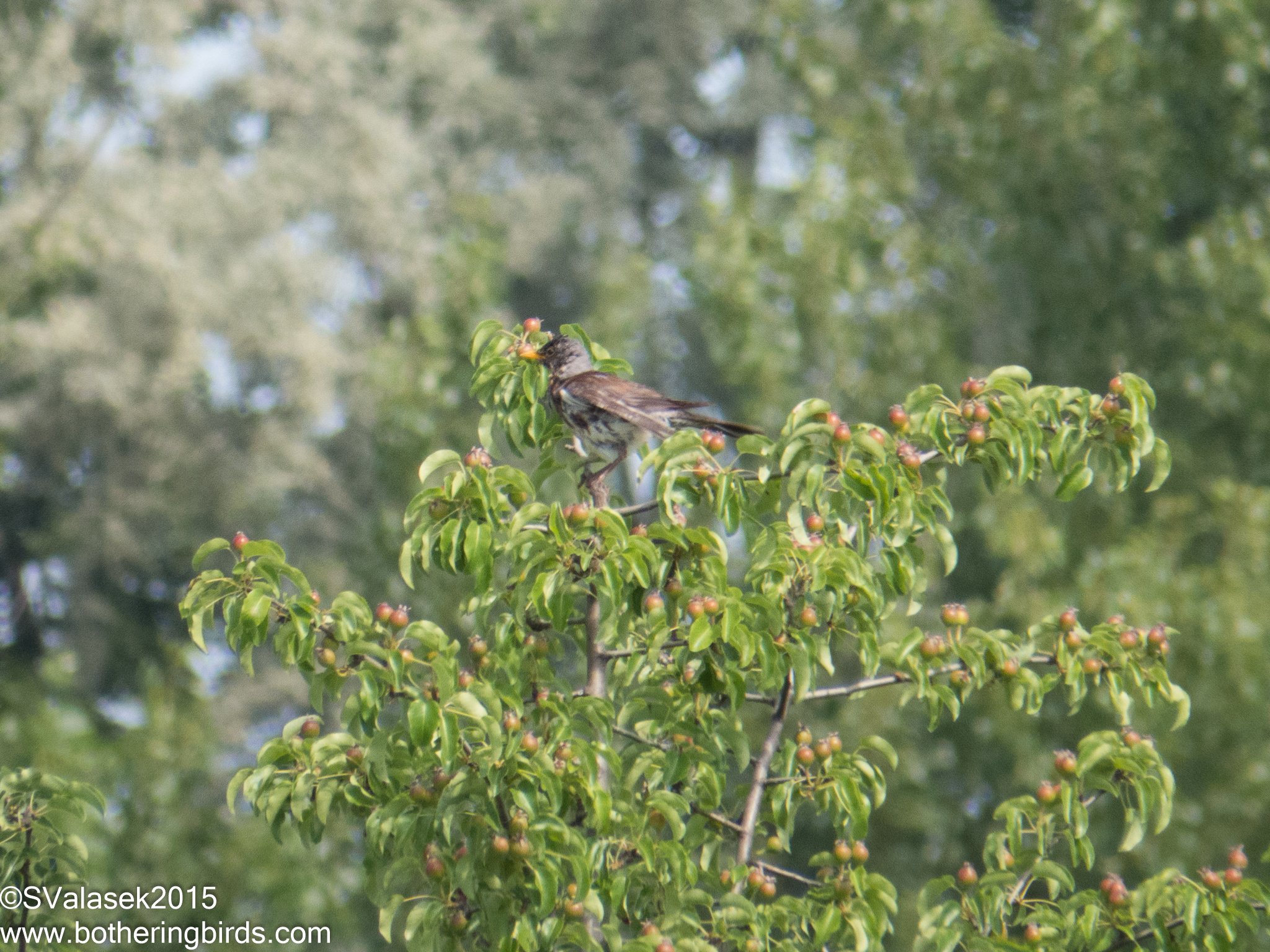I wrote about the first day of my recent trip to Austria in the previous post, which you can find
here.
The second day would take us to various salt ponds and reed-beds in the Nuesiedler See Nationalpark, which surrounded Illmitz, Austria, the town in which we were staying. In the morning we boarded our White-Whale of a motor coach and went to visit two places with interesting names: Oberstinkersee, or the "big stinky lake", and nearby Hölle, or "hell". The first was a rather large pond with lots of waterfowl present. We would see Common and Red-Crested Pochards, Mallards, Great Egrets, Mute Swans, Northern Shovelers, Garganey and Little Egrets. But a bird that caused lots of excitement for our local guide,
Leander Kihl, was a Fieldfare. This Fieldfare was seen taking food towards a nest, and made this only the second record of nesting in the region.
 |
| Fieldfare - Oberstinkersee, Austria |
While on our way to get some very good looks at a Greater Reed-Warbler from one of the multiple hides and observation platforms in the area, someone noticed an odd living arrangement in a rather large birdhouse.
 |
| Eurasian Kestrel Chick and Sparrows - Oberstinkersee, Austria |
If you look closely, you can see a Kestrel chick peaking out of the one door and Tree Sparrows just around the corner. Some of us speculated that maybe the sparrows were breeding Kestrels that would think of sparrows as family and thus leave them alone.
One of the lifer ticks for me on the second day would become a common bird seen throughout the week, Red-Backed Shrikes. We would see them singularly or in pairs pretty much everywhere else that we visited for the remainder of the week.
 |
| Red-Backed Shrike - Oberstinkersee, Austria |
We left the Oberstinkersee and continued on just a short distance to a section of the reed beds which surround the Nuesiedler See. The motor coach dropped us at a large tower and we walked north along a road with fields and trees to our right and the reeds to our left. We saw dozens and dozens of Red-Crested Pochards and a hundred-odd Graylag Geese in the middle of their molt. I would pick up a lifer Nightengale singing away in a thick piece of brush, while hearing a few others. I also got my first glimpse of Bearded Reedlings out in the reeds, but no good photos. We ended our walk with a view of the lake and some local horses who were helping to control the grasses.
 |
| Nuesiedler See - Illmitz, Austria |
After a lunch stop back at the Hotel Post in Illmitz, we went West towards more reeds and a walk to a bit of water where we should be able to see Pygmy Cormorants. As I mentioned before, it was very hot, nearly 35°C that afternoon and the walk was 2.5km along an exposed, dirt road. It really made me home-sick for New Mexico. The first birds that we saw off of the bus was another Red-Backed Shrike hunting from some kind of pole. We would see Marsh Harriers, Storks, Spoonbills, Tree Sparrows and some Eurasian Kestrels along the way. And more than once we would hear the booming calls of Bitterns from dense reeds, but never saw any.
At the end of the road was a house and an observation tower known as Sandeck. There were some other photographers already there and it seemed to be a popular spot. One of the reasons is that this area is the home of a rare breed of white donkeys, some of the last ones in Austria.
 |
| Austrian White-Donkeys - Illmitz, Austria |
However, opposite of the donkeys was a flurry of activity. Lots of ducks and Graylag geese were on the water and the surrounding wetlands. We saw Pintails, Mallards, Common and Red-Crested Pochards, Gadwalls, Garganey, Shelducks and even some Northern Shovelers. There were also Mute Swans, Great Egrets and Little Egrets present too. And flying far out and back and forth were some Pygmy Cormorants. Everything of interest was too far for my camera, but the scene was impressive.
 |
| Scene from Sanddeck - Nuesiedler See, Austria |
After we had our fill of the waterfowl, we were told to look into one of the trees behind us. Up on a nest was a Long-Eared Owl.
 |
| Long-Eared Owl - Nuesiedler See, Austria |
But the reason that the other photographers were around was because of a different nest. There were Hoopoes nesting in the area. We would watch the adults fly into trees and then fly off. But the one was up in the roof of a building along the dirt road which we had just walked down. Once we had it in our scopes it was easy to see two young Hoopoes looking for their next food delivery.
 |
| Hoopoe chick - Nuesiedler See, Austria |
 |
| Hoopoe Chicks - Nuesiedler See, Austria |
On the long, hot walk back to the bus we got some good looks at a Turtle Dove in a tree and then a (Black-Crowned) Night Heron flew over towards the lake proper. And just as we arrived back at the Seegasse we saw more Hoopoe adults carrying food back along the road. We figured that they were the adults from the nest that we had seen, but when we watched them quickly flying back going the other way we, figured that there were 2 nests in the area.
The end of the second day saw me get a quite a few lifer ticks, 17 in all and nearly half of the ones that I would see during the week. But I would get better looks at most of those later in the week, and better photos too. Day three would be taking us East towards Hungary looking for Great Bustards and Bee-Eaters.
Cheers.











Excellent
ReplyDelete